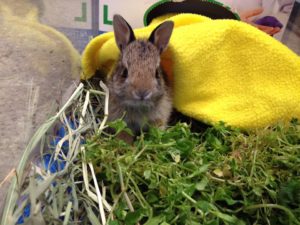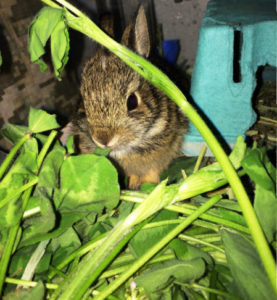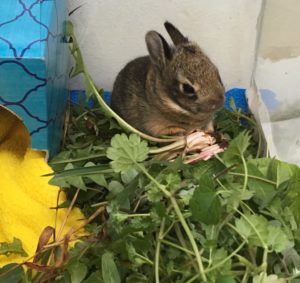Eastern cottontails are by far one the most commonly admitted species to wildlife rehabilitators every year, usually coming in as infants or juveniles. They often come into rehab at the age when they are weaning off milk and transitioning to solid foods.
Cottontails are one of the most stress-sensitive species seen at rehab clinics, so anything we can do to help them unwind and chill out while they are in rehab is the goal.
For these reasons, a large variety of fresh wild greens will hopefully act as a relaxing comfort food and also introduce the young rabbits to some of the natural salads they may encounter in the wild post-release.
Below, I have shared in more detail about the preferences of cottontails. Determining this is not an exact science. Rabbits do not return surveys. However, experts can interpret something about the popularity of foods based on the quantity and frequency of a food item in a diet– which is how these preferences were determined. For an item listed as less popular with rabbits, we cannot with complete surety say they do not “like” the item. It may just be they do not have as much access to the food. So all these foods hold value to collect and offer as variety and enrichment.
When I use the term “greens,” I am referring to non-woody parts of plants— the leaves and non-woody stems and above-ground parts of the plant.
When I use the term “browse” I am referring to the small twigs, branches, in some cases even bark of a shrub or tree, along with any green leaves that are still attached.
I have noted when an item has a potential to be toxic. Please read the section on risky plants and search the item in the database for potentially more info about the nature of the risk.
Dr. Peach Van Wick, DVM, MS, Research Fellow at the Wildlife Center of Virginia explained to me that rabbits’ gastrointestinal tracts are most closely similar to horses. While the toxicological studies of rabbits may be fewer, there have been a lot more studies of horses. I’d look more closely at any plant that is toxic to horses, if I was considering feeding it to a rabbit.

Popularity rating:
Highest 5 Star= Favorite food!
4-Star= Preferred
3-Star= Eaten
2 Star= Eats Somewhat
Lowest 1 Star= Nibbles
Cottontail Greens
| Greens | Genus, Species | Popularity | Is there a warning associated with these greens? |
| sow thistle | Sonchus spp. | Favorite | |
| wheat | Triticum spp. | Preferred | YES |
| clover, red | Trifoium pretense | Preferred | YES |
| crabgrass | Digitaria spp. | Preferred | |
| dock | Rumex spp. | Preferred | YES |
| plantain | Plantago spp. | Preferred | |
| goldenrod | Solidago spp. | Eaten | YES |
| panicgrass | Panicum spp. | Eaten | YES |
| strawberry | Fragaria spp. | Eaten | |
| yarrow, common | Achillea millefolium | Eaten | YES |
| alfalfa | Medicago spp. | Eaten | YES |
| aspen | Populus spp. | Eaten | |
| bentgrass | Agrostis spp. | Eaten | YES |
| blackberry | Rubus spp. | Eaten | |
| bluegrass | Poa spp. | Eaten | YES |
| smartweed | Polygonum spp. | Eaten | YES |
| laurel, great | Rhododendron maximum | Eaten | YES |
| lespedeza | Lespedeza spp. | Eaten | |
| lupine | Lupinus spp. | Eaten | YES |
| orchardgrass | Dactylis glomerata | Eaten | YES |
| quackgrass | Elymus repens | Eaten | YES |
| rose | Rosa spp. | Eaten | |
| timothy | Phleum pretense | Eaten | YES |
| aster | Aster spp. | Eats somewhat | |
| beggar-ticks | Bidens spp. | Eats somewhat | |
| bristlegrass | Setaria spp. | Eats somewhat | YES |
| buttercup | Ranunculus spp. | Eats somewhat | YES |
| chickweed | Stellaria spp. | Eats somewhat | |
| cinquefoil | Potentilla spp. | Eats somewhat | |
| corn | Zea mays | Eats somewhat | YES |
| crowngrass | Paspalum spp. | Eats somewhat | YES |
| dandelion | Taraxacum spp. | Eats somewhat | |
| hawkweed | Hieracium spp. | Eats somewhat | |
| millet | Echinochloa spp. | Eats somewhat | YES |
| mustard | Brassica spp. | Eats somewhat | YES |
| pigweed | Amaranthus spp. | Eats somewhat | YES |
| pine | Pinus spp. | Eats somewhat | |
| ragweed | Ambrosia spp. | Eats somewhat | YES |
| rye | Secale cereale | Eats somewhat | YES |
| spruce | Picea spp. | Eats somewhat | |
| violet | Viola spp. | Eats somewhat | |
| Virginia creeper | Parthenocisus spp. | Eats somewhat | YES |
| pussytoes | Antennaria spp. | Nibbles | |
| vervain | Verbena spp. | Nibbles | |
| wheatgrass | Elmyus spp. | Nibbles | YES |
| wood sorrel | Oxalis spp. | Nibbles | YES |

Cottontail Browse
In addition to greens, there are a large number of shrub and tree browse that rabbits may eat.
Rabbits—especially adults in winter— will nibble on twigs and even young bark to get to the cambium layer under the bark. Browse should be kept in water during transport, kept in the cool shade and offered as soon as possible after cutting. It does not save well. Branches with leaves still attached can be offered in the enclosure.
| Browse | Genus, Species | Popularity | Is there a warning associated with this browse: |
| sumac | Rhus spp. | Favorite | YES |
| hackberry | Celtis spp. | Favorite | |
| honeysuckle, Japanese | Lonicera japonica | Favorite | YES |
| basswood | Tilia americana | Preferred | |
| ash | Fraxinus spp. | Eaten | YES |
| aspen | Populus spp. | Eaten | |
| barberry | Berberis spp. | Eaten | YES |
| birch | Betula spp. | Eaten | |
| blackberry | Rubus spp. | Eaten | |
| blueberry | Vaccinum spp. | Eaten | |
| buckthorn | Rhamnus spp. | Eaten | YES |
| burning bush | Euonymus spp. | Eaten | YES |
| dogwood | Cornus spp. | Eaten | |
| elm | Ulmus spp. | Eaten | |
| greenbrier | Smilax spp. | Eaten | |
| hemlock | Tsuga spp. | Eaten | |
| hickory | Carya spp. | Eaten | |
| honeylocust | Gleditsia spp. | Eaten | |
| hornbeam, American | Carpinus caroliniana | Eaten | |
| huckleberry | Gaylussacia spp. | Eaten | |
| laurel, great | Rhodadendron maximum | Eaten | YES |
| lespedeza | Lespedeza spp. | Eaten | |
| locust, black | Robinia spp. | Eaten | YES |
| maple | Acer spp. | Eaten | YES |
| mountain laurel | Kalmia spp. | Eaten | YES |
| oak | Quercus spp. | Eaten | YES |
| rose | Rosa spp. | Eaten | |
| sumac | Rhus spp. | Eaten | |
| sweetfern | Comptonia peregrina | Eaten | |
| viburnum | Viburnum spp. | Eaten | |
| alder | Alnus spp. | Eats somewhat | |
| pine | Pinus spp. | Eats somewhat | |
| walnut, black | Juglans nigra | Eats somewhat | |
| bittersweet | Celastrus spp. | Eats somewhat | YES |
| chokeberry | Aronia spp. | Eats somewhat | YES |
| hawthorn | Crataegus spp. | Eats somewhat | YES |
| hazelnut | Corylus spp. | Eats somewhat | |
| New Jersey Tea | Ceanothus americanus | Eats somewhat | |
| pear | Pyrus spp. | Eats somewhat | YES |
| spruce | Picea spp. | Eats somewhat | |
| willow | Salix spp. | Eats somewhat | |
| witch hazel, American | Hamamelis virginiana | Eats somewhat | |
| poison ivy | Toxicodendron radicans | Nibbles | YES |
| sassafras | Sassafras albidum | Nibbles |

